Beyond the Trees
Mariam Zulfiqar and Dr David Edwards
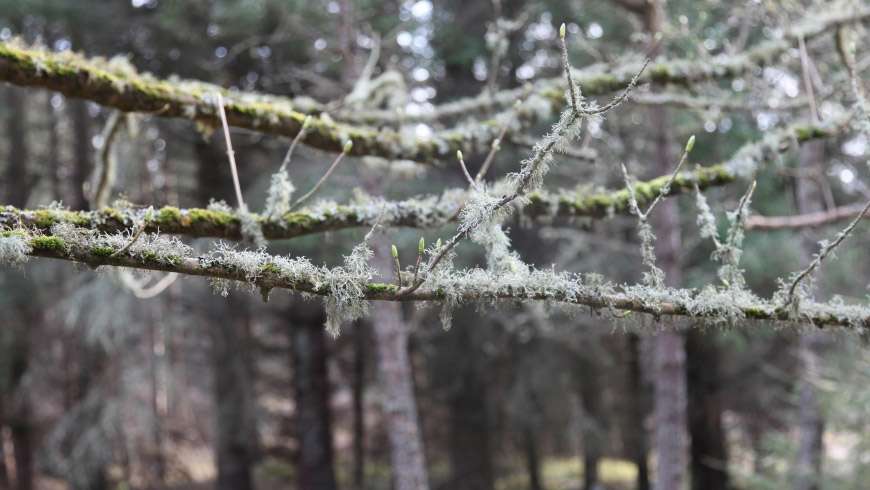
In June 2021 Forestry England, Film and Video Umbrella and artist Ruth Maclennan put out an open call asking people to submit audio and video footage of forests across the world. The contributed footage would form a cumulative snapshot of a diverse range of forests from various parts of the planet and would be used to create a new artwork called Treeline. This new work would be launched to coincide with COP 26, the UN's summit on climate change being held in Glasgow in November 2021 where leaders from around the world gathered to discuss the local and international climate-related issues we all face.
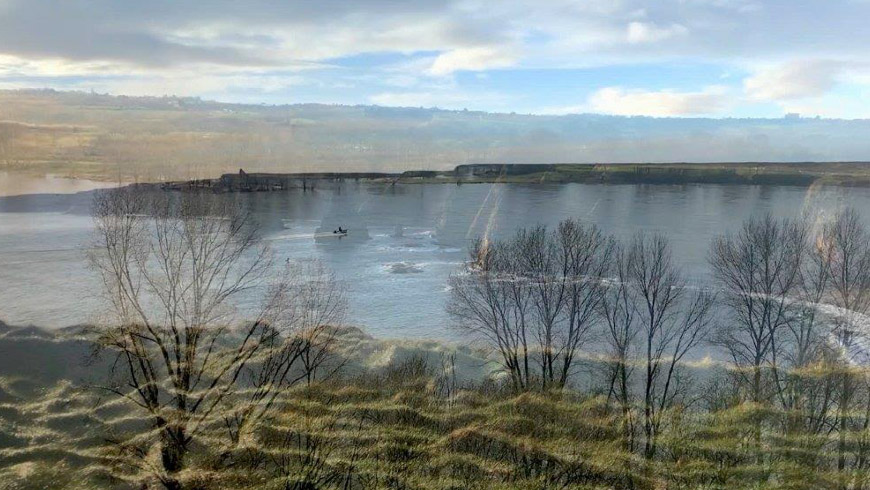
Horizon 13th lap, 2020, film still
The idea of inviting international submissions was an extension of how the artist had created Horizon, 2020. This work, created during lockdown, is made from short video sequences of views of horizons from different points across the world submitted by the artist's friends and peers. The repeating reference point of a central horizon line, shared by each of the sequences, functions as a formal framing device by which geographically distant locations can be placed side by side, evoking the common perspective uniting these disparate views at a time when people's horizons were being shrunk by the restrictions imposed by the pandemic.
In a similar fashion, the international call-out for Treeline was an antidote to the parochial way in which we have historically viewed and authored nature. It came at a moment when the pandemic had generated a renewed recognition of our interdependence with the planet's ecosystems, and when lockdown restrictions had sharpened awareness of how much our physical and emotional wellbeing could be enhanced through access to green spaces in the form of gardens, parks and forests.
As people walked around the British landscape, and reconnected with so-called 'wild' nature, how many would be aware that the landscape they were experiencing has been continuously managed for centuries? And how many would be able to tell the genealogical history or migratory stories of the plants and trees that are now such a familiar feature of the contemporary British countryside?

Still from Treeline, 2021
Treeline starts off with audio recorded in Peru, submitted by young women from indigenous Ashaninka communities. The work then takes viewers through forests, rural locations, parks and urban settings in over 30 countries including Australia, New Zealand, Brazil, Pakistan, India, Egypt, Turkey, Cameroon, Rwanda, Ethiopia, Russia, France, Spain, UK, and USA. In total over a hundred people, organisations and charities submitted more than 200 pieces of footage giving us a glimpse of trees, landscapes, ecologies and the people that engage with them across the world.
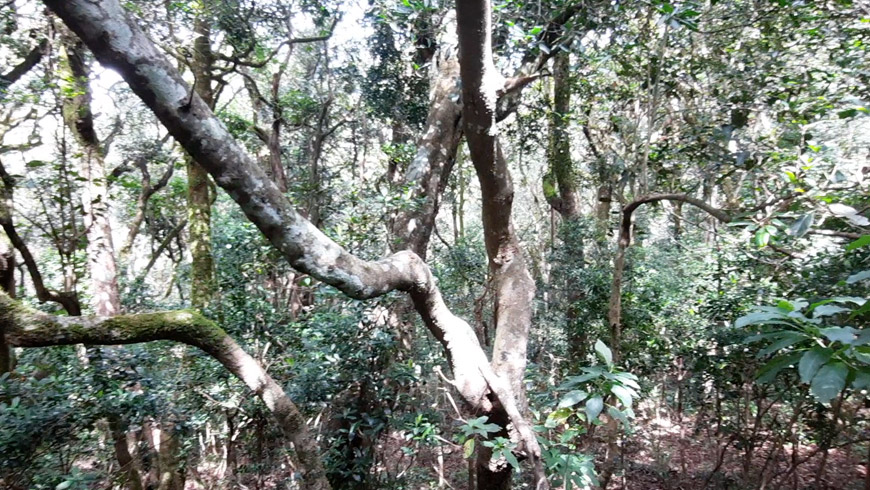
Still from Treeline, 2021
The film is segmented into what feels like chapters, and submissions are edited together via a poetic and intuitive artistic logic that invites us to look beyond known or conventional scientific classifications. With the diversity of the submitted footage, and in the absence of a didactic narrative, the viewer has to make sense of what they are looking at.
The film begins with darkness and a garish high metallic sound which reveals itself as the sounds of tropical forest insects. The first 'chapter' comprises a substantial sequence of short sections of film of forests and trees in the landscape, mostly panning the same direction, from left to right, providing a sense of continuity between them yet taking the viewer between multiple locations across the world.
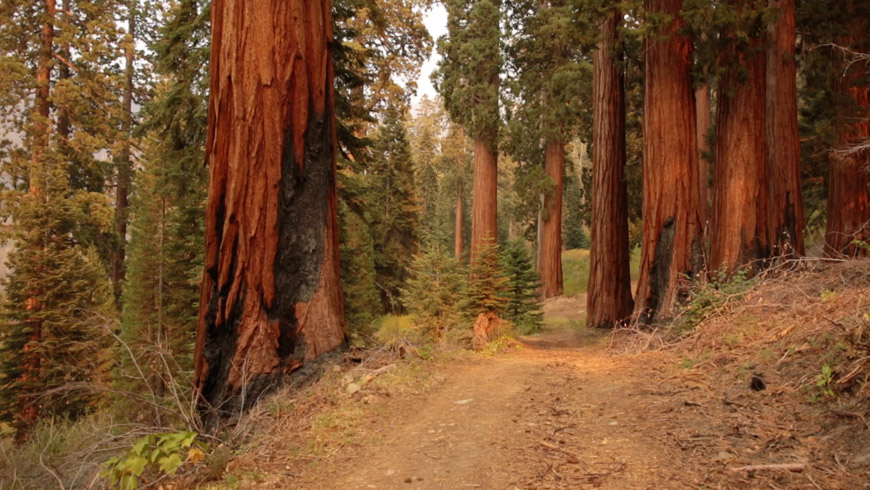
Still from Treeline, 2021
Later on, another chapter focuses on people and communities working with forests - planting trees, felling them and transporting logs. Shorter sections highlight risks to the forest (such as fire and storms), aerial flights over the canopy, and close-ups of varieties of bark on tree trunks. The film finishes with one such close-up of an extraordinary looking insect, a member of the South Asian Phylliidae, also known as leaf insects or 'walking leaves'.
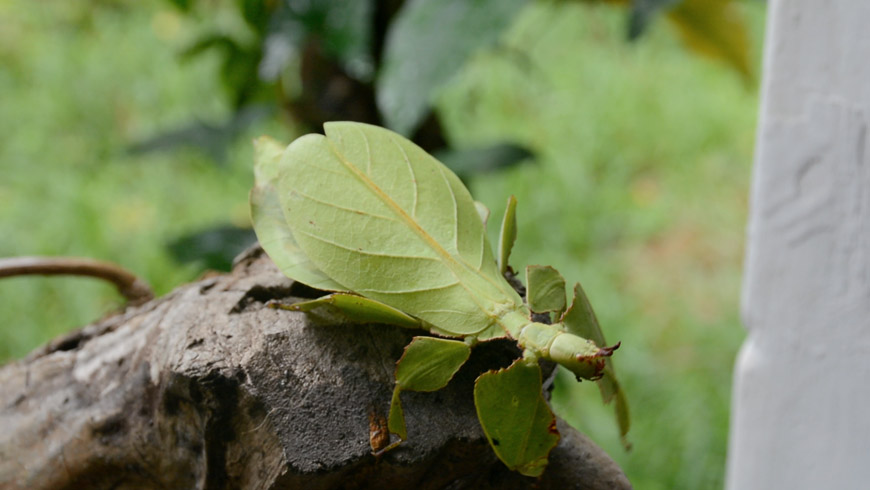
Still from Treeline, 2021
The soundscape is equally diverse, with sounds from insects, birds, mammals and humans being featured alongside the noise of trucks, chainsaws and other heavy machinery. The sense of continuity across the separate fragments of film is enhanced by allowing the soundtrack for a given section run on to the next section and beyond.
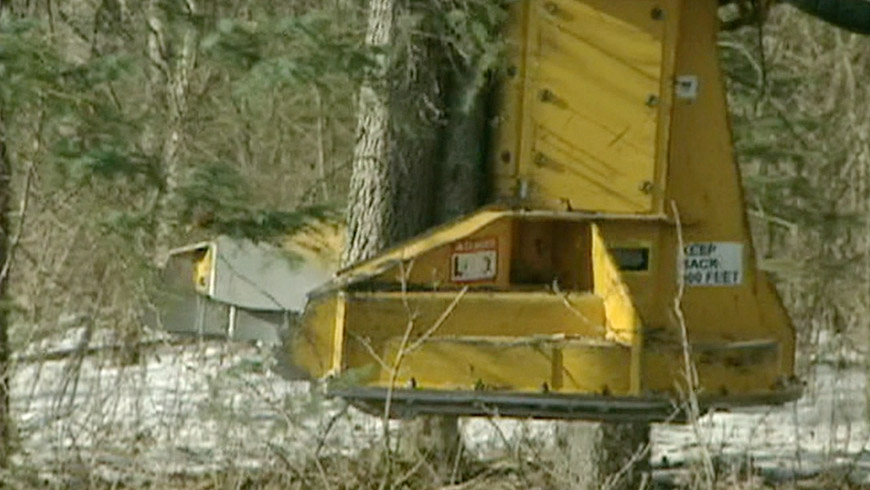
Still from Treeline, 2021
When I (Mariam) started at the Contemporary Arts Programme at Forestry England my knowledge of the English landscape was fairly basic, although I had some inkling that it wasn't necessarily as quintessentially English as the name suggests. For example, I have always had a curiosity about UN-protected RAMSAR wetland sites, which provide habitats for migrating birds. The UK has hundreds of these sites as the British Isles are situated along one of eight international flightpaths for migrating birds. Known as 'flyways', these routes connect distant parts of the world, with the East Atlantic Flyway connecting parts of Africa to Europe and North America. A flick through the publication 'Songs of Place and Time' further underlines how birds, bird song and wetlands complicate the way we politicise our surroundings via possessive and reductive titles such as 'the English landscape'.
In Britain, as in many other parts of the world, we really don't have to go that far to see an international influence within the local landscape. The trees that grow across these isles are a mixture of what's called 'native' species such as rowan, pine and oak and international 'non-native' or 'exotic' species that have been introduced over the centuries.
Sycamore was introduced to Britain around the 15th or 16th Century. The cedar of Lebanon was first introduced around the 1600s and was a feature of English garden design popularised in the 1700s by landscape architects such as William Kent. European larch from the mountains of central Europe was introduced around 400 years ago for timber production. Eucalyptus was first introduced to Britain following Captain James Cook's voyage to Australia in the 1700s, and the 1800s saw the introduction of the commercial timber species Douglas fir and Sitka spruce by plant hunter David Douglas.
Similarly, evidence of species introduction can be found in countries across the world. The flamboyant for example, a tree with orange flowers visible across Barbados, was originally from Madagascar off the coast of East Africa, and the breadfruit tree, whose saplings were thrown overboard during the mutiny on the 'Bounty', originates from countries such as New Guinea and the Philippines. DNA research shows that it is linked to the Breadnut tree and moved around Polynesia some 3000 years ago. Later it would be moved again by the likes of Joseph Banks who first saw the tree in Tahiti and Captain Bligh who attempted to move it to the Caribbean as a source of food for the rapidly expanding and inhumane plantation economy fuelled by slavery. Research being conducted on tree DNA shows us that all citrus trees originate from the foothills of the Himalayas.
Over time, and in most of the countries where species introductions have taken place, some of these species have become familiar parts of our urban and rural environments. They have also evolved, producing descendants that hold ancestral DNA, while adapting and thriving in the environmental conditions in which they find themselves. They evidence an arrival, a translocation, an introduction, and a subsequent evolution.
It is not just human intervention that has moved tree species across the world. Long before human colonisation and globalisation intensified the movement of plants, animals and humans from one part of the world to another, the spread of trees and plants had been occurring through historical changes in climate, shifting landmass, and aided by birds and winds. Genetic markers demonstrate that oak colonised Britain from refugia located in southern Spain as the ice retreated and temperatures rose following the last glaciation. In the case of the Scots Pine, Scotland's national tree, ironically its native distribution in Scotland actually represents an isolated fragment on the western-most periphery of its main distribution across the rest of Europe and Asia.
Colleagues at Forestry England are involved in a number of activities, from timber production to conservation, rewilding and the reintroduction of species such as pine martens, white tailed eagles and beavers. Historically the Forestry Commission was formed after the depletion of wood during the First World War. Its remit in the past was to replenish the stock and continue to meet demand for timber. At first, this led to the creation of large monoculture plantations, although from the 1980s these became increasingly diverse in their species and structural composition.. Even so, as a country, we are now bottom of the G7 and rank twelfth from the bottom in the world when it comes to biodiversity intactness. The overall impact of plantation forestry on biodiversity is not straightforward, however; for example where heavily grazed open land is replaced by habitats for red squirrels, goshawks and crossbills. Perhaps more significantly, it's the confluence of 400 years of industrialisation, urbanisation, intensive land use and the pollution that these have caused, including light pollution, that has disrupted the conditions needed for much of our biodiversity to thrive.
Now there is a new line of thinking, one that recognises that being the largest manager of land in the country comes with the opportunity and responsibility to affect positive change at scale. With ambitious new targets for woodland creation set by governments across Britain, the future of our biodiversity is now in the spotlight. But with a rapidly changing climate even this approach is not without its friction. Will our native tree species adapt fast enough to cope with predicted rates of change? Or do we need to intervene, and use planting stock from more southern latitudes where current climates match those predicted for Britain in the near future? Our colleagues in Forest Research are working to generate evidence of the speed of genetic adaption and provide clear guidance for policymakers and practitioners as part of the newLEAF project led by UK Centre for Ecology and Hydrology (UKCEH) and funded by UK Research and Innovation (UKRI). And, as DNA research shows us, the distinction between 'native' and 'exotic' isn't quite as simple as these loaded terms suggest.
The issue of genetics is a complicated one. The way that genetic variation is measured can lead to very different conclusions about 'belonging' depending on the precise markers selected for analysis. One only has to look at the political history of human interaction across the world to know how scientific evidence on the variability and distribution of DNA has been interpreted and leveraged to fit specific political agendas around purity. This logic has radiated out and influenced discourse and thought on plant species and populations too. Purity as a filter or a frame is reductive and oversimplifies complexity, with potentially negative impacts on public understanding and management actions on the ground.
The term 'Treeline' typically indicates the altitude above which trees cannot survive due to wind and cold. The artist has extended the meaning of this word to encompass the changes in land-use as you traverse the landscape that prevent the forest from expanding any further. Can Treeline become a broader metaphor that encompasses not only the environmental and elemental boundaries faced by trees, but also the limits we face when trying to better understand our surrounding environments?
With DNA evidence presenting a complicated family tree of trees, what are the other edges and lines we need to recognise and transcend in order to reach new understandings about trees, ecology and nature? Is it time to start with language and reconsider how we interpret loaded terms such as native and exotic, and their associations with belonging, when speaking about plants and trees? As debates about these issues continue in scientific and conservation circles, is it possible that the future lies somewhere else, and is not simply resolved by a win for one of these two opposing arguments? Perhaps the answer lies in understanding the DNA which tells of populations of trees that have moved, migrated, settled and evolved over time, but also in artworks such as Treeline, which invite us to imagine a space that exists beyond native and non-native classifications.
Treeline opens up a space to discuss how we group and categorise nature, and question the filters through which we make decisions. The film's many viewpoints come from participants across the world, and while the editing process is filtered through the perspective and logic of the artist, it sidesteps any one single narrative by presenting a panoramic, albeit patchwork picture of trees, forests and the people and communities living and working in these spaces today. In its open, inclusive, user-contributed methodology, it is very much a film of our time. It has leveraged the international reach of social media to radiate an invitation. People with access to digital technology and green spaces responded. And precisely because of the plethora of information and multiple perspectives, the question about how best to process and make sense of the information becomes all the more urgent.
In preparing this text, Treeline offered a point of convergence for the Art Programme at Forestry England and the scientific work of its partner agency Forest Research. While these departments operate in parallel, the artwork created the conditions for our lines of enquiry to intersect, opening up a space for cross-disciplinary dialogue. During the course of writing this text we have allowed our own horizons to be broadened by the perspective of another discipline.
Ruth Maclennan's Treeline has ended up being much more than a film. In its methodology, it is a powerful metaphor suggesting that a fixed narrative isn't what's needed for the future. It is a springboard from which we can challenge and question the language, narratives and conceptual frameworks we collectively use as we head into an increasingly uncertain environmental future.
Mariam Zulfiqar was the Curator of Forestry England's Contemporary Arts Programme.
Dr David Edwards is the Research Impact coordinator at Forest Research, the research agency of the Forestry Commission.
